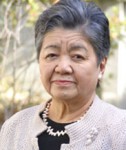[SERIES: INTERVIEW] "DIET AND LIFE" — FOR HUMANS TO BECOME PEOPLE

Kawashima Midor
Kawashima Midori: The modern day nursing scene undervalues the significance and importance of eating through the mouth. Being in a position to coach and encourage nurses in the field, I always tell them, “Think more about the meaning of eating through the mouth. That’s where you find the role of nursing.”
Tatsumi Yoshiko: I think it was in Ohmi, Hikone that there was a patient who had completely given up on eating, saying he didn’t want to do it anymore. The doctor said, “Think of something, anything you would want to eat,” and the patient said, “I want to eat funazushi [a type of fermented sushi].” So he ate a piece, and his body successfully accepted it. Then he ate funazushi every day until he recovered his health and was able to go home.
Kawashima: Such stories really are true.
Tatsumi: If you analyze the nutrients in funazushi, you can probably learn how much of what is in it. But supplying the same nutrients through infusion or a needle isn’t the same thing. There are psychological factors to this, aren’t there?
Kawashima: That’s the difference between medicine and nursing. In medical terms, you have to think about nutrients and calories and how many grams of what you take in. But in terms of what we nurses have long experienced, even a meal completely lacking in nutritional value can have huge significance when it means a great deal in the patient’s history and enters through the mouth.
Tatsumi: Can you expand on that?
Kawashima: When something enters the stomach – and it doesn’t have to be funazushi – the esophagus and stomach start moving. This prompts the parasympathetic nervous system to take control. While it is important that the autonomic nervous system is balanced, when the parasympathetic system takes control, the mind and body relaxes, the heart beats steadily, you breath steadily and everything is steady, while the digestive system alone works hard. And when food enters the stomach and the parasympathetic system kicks in, it stimulates activity of cells called natural killer cells that enhance immunocompetence, which is an effect that has mostly established itself as theory. This brings out power in the body to cure illness.
Even a glass of water will do. Putting something into your stomach from your mouth has so much to do with immunity. Nursing is not about giving injections or medicine or performing surgery; it is about letting a patient’s body exert its innate strength. So in terms of heightening natural immunity, eating meals using one’s own mouth is the best way for a patient.
Tatsumi: Even a spoonful of soup should be offered through the mouth…?
Kawashima: Yes. Even for the terminal patient, it leads to life tomorrow. A mere bowl of soup won’t cure cancer in medical terms, but the patient will gain motivation: “Good, I’ve lived another day. I’m going to do it again tomorrow.” That’s why eating through the mouth has huge importance. I summarized what I wanted to say today, and that’s what it comes down to. I could end this interview right here. [laugh]
Tatsumi: Modern medicine tends to resort to gastric fistula, using infusion or putting holes in our bodies. But we should rather value the importance of giving “through the mouth” don’t we?
Kawashima: That’s right.
A piece of melon in my father’s mouth
Tatsumi: When my father was hospitalized for cerebral thrombosis and was just regaining consciousness, we were first cautiously giving him fluids such as tea. But it occurred to me that it would be better for him to chew fruits, so I cut him a bite-sized piece of melon, wrapped it in gauze and put it in his mouth, saying, “Father, chew on it. It’s melon.” Of course, we raised him up and massaged his throat first. He slowly drank down the juice as much as his strength to chew allowed, and he smiled in delight. I eventually began feeling sorry for feeding him just melons and peaches, so I grilled some steak, flavored it with soy sauce and said, “Look, we’re having steak today,” and had him chew on it. He went, “Ooh!” and was really happy. He chewed slowly and the meat juice gradually went down, so this steak idea was a big success. Our doctor complimented me on an excellent job of nursing.
Kawashima: One would usually be too concerned about drinking and forget about chewing, but this shows that chewing is really important.
Since you raised the topic of gastric fistula, let me share one case with you.
A patient that one of my students was caring for had his entire esophagus removed due to cancer, so at the hospital they were feeding fluid nutrients directly into his intestines through gastric fistula. But he kept having bad diarrhea day after day. This 75-year-old man was also acting abnormally from stress of not being able to eat through the mouth. He walked the corridors stark naked, he did dirty things when other patients were eating and my student didn’t know what to do with him. The man was stressed that he didn’t feel human, unable to drink or eat from his mouth.
This man was ordinary and calm before the surgery, so my student came up with an idea and told him, “We can’t drink, but let’s gargle,” and had him gargle with Calpis (a noncarbonated Japanese soft drink). He said, “Oh, that feels better,” and was extremely happy for the next four or five days. But then he started his abnormal behavior again. So my student suggested to the doctor in charge, “Why don’t we attach a Lapack (a pouch used for colostomy) to the hole we’ve opened for the artificial esophagus and let everything he drinks from his mouth drain into it?” The idea was approved, and he was gradually able to drink fluids and miso soup through his mouth. His terrible diarrhea then stopped all of a sudden, the electrolyte balance in his blood returned to normal, and he stopped behaving abnormally. So he was fine without the artificial esophagus and was able to go home.
Tatsumi: If everything he swallows from his mouth goes out from a hole in his throat that means none of it is supplying him with nutrition, right?
Kawashima: That’s right. But this case vividly tells us how extraordinary it is for us to swallow food from our mouth and through our throat.
Tatsumi: I heard that you also had some hardships nursing your husband.
Kawashima: Yes. For a year, I nursed my husband who had surgery for lip cancer, and he died four years ago. For three meals everyday without fail, I fed him the same food I ate but I blended it in a mixer and had him drink it. When I was busy and eating a simple cup of instant noodles, he would tell me, “That looks good,” in writing because he couldn’t talk. So I blended noodles in a mixer and had him drink it through a special tube inserted in his throat that the Cancer Institute Hospital had made for him.
Tatsumi: While you were doing that for a year, didn’t you ever consider the common method of gastric fistula?
Kawashima: I didn’t quit my job, so I had nurses come care for him during the day while I worked, and they frequently suggested gastric fistula to my husband. But each time they did, my husband replied, “It’s important that I eat through the mouth, like a human.” I still have the memo he wrote those words on. I think that idea had given him the power to live.
In the past, the basic concept of nursing was to think earnestly, in the patient’s shoes, about, “How can I let a patient with a failing appetite eat?” But today, with the advent of gastric fistula and intravenous hyperalimentation (infusion of high-calorie IV fluid), nurses are neglecting the value of eating through the mouth, which I think is frightening. Although I can understand that we need such technology since some patients could not survive without them.
What patients take are not nutrients
Tatsumi: Listening to what you have said up to this point, I get the impression that doctors and nurses have fundamentally different notions on eating.
Kawashima: For doctors, the notion of food is biologically, biochemically and dietetically centered on the mechanism of how a patient chews, swallows, digests, absorbs, converts to energy, and excretes food. And in terms of its association to illness, they studied how much of what a patient should eat for which illnesses, or what he should not eat from nutritional and caloric perspectives.
Tatsumi: But humans don’t eat for the sake of taking in calories, nor do we usually think about how many grams of proteins we should take in. We’ve always eaten for good taste and enjoyment, haven’t we?
Kawashima: Of course we have. In terms of how much of what we eat, humans have decided how much a single meal will be through experience and wisdom accumulated throughout their long history; about how each person grew up developed his or her preferences and eating habits.
What I want to say here is that one primary objective of nursing is to establish eating environments unique to each patient, and to have each person eat with true pleasure and feel, “Oh, this tastes good.” The fundamental stance of nursing is to have a patient eat as close to his or her healthiest state as possible and gain the power to live.
There have been actual cases where a patient with dementia, a patient unconscious from cerebral contusion caused by a traffic accident, or a person in a persistent vegetative state have improved their illness or returned to normal when we stimulated their individual history or nostalgic memory. Simply said, while doctors see the illness, nurses focus on the individual person. We must delve into and seek out the history of each patient and offer completely humane care.
Tatsumi: In my view, what patients eat is not nutrition. Eating is the most basic activity for a human to be human. If a person can eat what he or she wants no matter how nutritionally irrational it may be, and eat it with pleasure, nothing can be better.
Kawashima: One exception is when patient has some restrictions to eating or they have to take therapeutic food. But even with therapeutic food, nutritionists say, “You have to eat this; think of it as medicine.” While I understand that they’re in the position to say so, I think there’s something not right about that.
I had hardly ever fallen ill, but about four years ago I had gallstone surgery. I was in the hospital for about 10 days, and unable to eat the whole time, so I was so excited about the first fluid meal that I was finally given, but I drank one sip of it and said, “Huh?” It felt like plain saltwater and I couldn’t identify what kind of soup it was.
Tatsumi: That awful quality of what we call “hospital soup” is really a problem. While I admit some hospitals do take great care with their food and are showing some effort, they have yet to do that in terms of soup.
Kawashima: I read your book, Supu no tehodoki – yo no bu [Basics of soup – Western style] (Bunshun Shinsho). You wrote, “Soup is the ultimate means of surviving this century. Anyone can make it, and it contains every aspect necessary in life, from baby food to nursing care.” I couldn’t agree more.
Tatsumi: In chapter 7 of that book, I wrote something like this. Let me quote from it.
A nursing expert once told me that a person nearing life’s end wants to eat ice. I think it would be wise to make ice out of brown rice decoct, vegetable consommé, gyokuro or sencha (high- or middle-grade green tea). Freeze it in an ice tray, chip off however much is necessary and offer it.
When we make food, we devote part of our life to it. Thus the life of the person who made it accompanies the ice and enters into every corner of the dying person’s cells. We become one with the person. Isn’t that a reason why we should want to offer good taste to a dying person? In this I think lies the ultimate significance of nature called fine taste.
This notion was deep down within me ever since I started my work on soup, but it took years to put it into words.
The soul of nursing and the soul of a mother are the same
Kawashima: We often refer to a “taste of home.” My elder Red Cross nurses who had served in the military often told me stories of how dying soldiers wished for the taste of home moments before their death. Every time I recall those stories, they remind me that eating has deep connections to the person’s history, and every time I wonder what nursing is, I realize that I have to, beyond anything, have a good understand of the meaning of eating and of the patient’s food history.
But I often worry if today’s children are blessed with such nostalgic memory of the taste of home. Standardized products are so common now and fewer people value the act of cooking from scratch.
Preparing meals day after day is indeed extremely tedious, but knowing its importance and cooking from the heart makes the food “taste like home.” In that sense, I think the soul of nursing and the soul of a mother cooking food are the same.
That’s why cooking food and the job of nursing have so much in common. That’s why I believe cooking good-tasting food with effort is an excellent means of training one’s nursing abilities.
Tatsumi: I am sure there is also something common in the sense of achievement one gets from cooking and receiving the praise, “That was so good,” and the feeling after nursing someone when the patient recovers his or her health and leaves the hospital with the words, “Thank you.”
Kawashima: Back when I started my career, I was taught, “Nurses aren’t rewarded with money. The best reward for a nurse is the ‘Thank you’ that a patient says when he recovers and leaves.” As long as we constantly maintain that stance, no work of ours is ever painful; it’s more a joy.
Knowing how to “expand” your cooking
Tatsumi: It’s a job that you can’t possibly do unless you think that way, isn’t it? In comparison, cooking is not such a burden when you learn how to expand one thing in many ways.
Kawashima: That your concept of “expanded cooking,” isn’t it? You stock up on Saturday and Sunday, make some basic dishes for the coming week, and have some expansion ideas ready that will get you eating just by heating them up in the microwave.
Tatsumi: Yes, exactly. You buy a big block of beef or pork, or even a whole chicken; salt it, and cook a week’s worth all in one pot. You can’t possibly eat it all at once, so you should expand from there to make a variety of different meals. I don’t know why, but few people eat in such ways of expansion that I do. I wonder why this is. In my view, people aren’t really as lazy as they think they are. I am so thoroughly lazy that when I buy, say, a whole daikon radish, I use it all and stew it. Some that I want to eat as sweet pickles I won’t stew too long; I pull them out when they’re about 80% cooked, slice them thinly and put them in a jar with sweet vinegar.
I believe you know this, don’t you? [Offers Kawashima a cup of soup]
Kawashima: Ah, yes, it’s Nightingale’s Beef Tea. During the Crimean War, Nightingale pleaded to Queen Victoria to send soup to the soldiers in battle, and this is what she had sent. It’s a famous story. It’s called tea but it’s beef soup stock.
Tatsumi: This [offers a different soup] is what I am fully confident could compare to Nightingale’s Beef Tea.
Kawashima: Is it the soup that you once served me and told me that it was sent to your father in battle?
Tatsumi: That’s right. My father in battle had sent my mother an illustrated letter that said he was longing to eat soba noodles. That got mother determined to send it to him in any way possible. She knew they would have soba, nori (dried seaweed) and relish but wouldn’t have tsuyu (broth dip), so she shaved a mountain of katsuobushi (dried bonito shavings) that she crushed with her hands, boiled this in sake, mirin and soy sauce until it lost all moisture, and sent it to the battlefield. That’s how this katsubushidenbu (powdered bonito) came to be.
Kawashima: Add hot water to it and it becomes a perfect tsuyu for soba – it’s a brilliant idea. It would also be good for sick patients. It tastes so good.
Tatsumi: Here’s another that I’d like you to taste. Take a teaspoon full of it in a cup and add hot water.
Kawashima: Mmm, I can feel every sip of it heats my body from deep down. What is it?
Tatsumi: It’s leek soup. It also contains chicken soup and a bit of ginger.
Kawashima: Not onion, but Japanese leek?
Tatsumi: Yes, Japanese leek. You make it just like how you make onion gratin, by stir-frying leeks thoroughly.
Kawashima: This is really good. This would be good to prevent your body from catching a cold.
Tatsumi: From around November every year, I eat this and bread for breakfast. It somehow prevents me from getting the flu.
An experiment that Professor Hayashi Toshimitsu studying herbal medicine at the University of Toyama conducted proved that mice fed Japanese leek were less prone to influenza. After reading a newspaper article about it, I took this soup stock and visited him in Toyama, and told him that this is what I make and drink. He said, “I’ve known about it academically, but I suppose this is how studies really play a role in people’s lives,” and was very pleased about it.
Kawashima: I’ll go home and try making it myself.]
Tatsumi: I found out that this Japanese leek soup tastes different depending on the leeks you use. The one I think that works best is the Shonai Red Leek produced in Yamagata.
Kawashima: How is that one different from other leeks?
Tatsumi: Its taste is very dense. I think the red color has some effect. It’s a little bit bitter, which is what’s also good about it.
Kawashima: Buy it from the producers and it supports the local community as well, right?
Tatsumi: Japan’s food self-sufficiency rate today is below 40%. If more people were able to understand real food and use it wisely, it would offer some support to the hard-working producers. I also think that it would ultimately be a power in solving the nation’s food issues.
Translated from “Shoku to Inochi – hito ga hito to narutameni,” Bungeishunju, November 2011, pp. 357-363. (Courtesy of Bungeishunju Ltd.)



